The SNES Classic had a sterling assortment of games from Nintendo's 16-bit star console, but it's hardly all that system has to offer a modern audience. In each installment of this fortnightly feature, I judge two games for their suitability for a Classic successor based on four criteria, with the ultimate goal of assembling another collection of 25 SNES games that not only shine as brightly as those in the first SNES Classic, but have equally stood the test of time. The rules, list of games considered so far, and links to previous episodes can all be found at The SNES Classic Mk II Intro and Contents.
Episode II: Time Bomb
The Candidate: Jaleco's Operation Logic Bomb
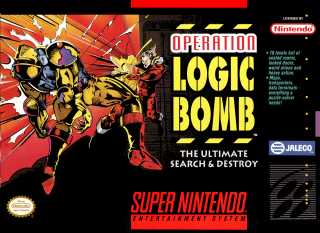
I have a pal named Cal. Cal repped a fairly obscure game in 2017 called Cryptark: a sort of gritty, sci-fi space scavenger shoot 'em up with roguelike elements that I was tempted to try out but later found was not to my liking. I feel like I reduced my pal Cal's morale when I implied Cryptark was as fun as a root canal, by my rationale, which is why I was eager to mend this entirely imagined discord between us by covering an old SNES favorite of his that I'd never before encountered: Operation Logic Bomb, a.k.a. Ikari no Yosai ("Fortress of Fury", which is a pretty sweet name also).
Actually the third in its series, with the preceding two entries released exclusively on the Nintendo Game Boy (the first of which was released in North America as Fortified Zone), Operation Logic Bomb is a top-down shooter that owes a small debt to Alien Syndrome, Sega's love letter to gory sci-fi creature-features such as Aliens and The Thing. You're still running around shooting, blowing up and burning all manner of weird extraterrestrial lifeforms that have taken over a human settlement, but rather than a purely linear stage-based format you're required to explore the surroundings, take detours to find new weapons which can unlock new routes, and power up and activate useful terminals that provide maps, health refills, and security footage that offers hints on the bosses ahead.
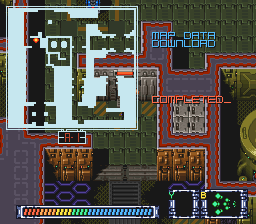
It's definitely a little more involved than your standard run-and-gun shooter, and that's best exemplified by the weapons it provides you. Initially you start with a direct fire machine gun and a spread shot, in true Contra fashion. However, the machine gun takes enemies down faster with its greater rate of fire, while the spread shot is better for hitting enemies at acute angles, which in turn allows you to stay clear of their limited output ranges. Just these two weapons alone sets the tone for the rest of the game, where you'll frequently have to consider which weapon to use and how best to approach enemies based on how they act and their firing patterns. There's only about a half-dozen enemy types in the game, not including bosses, but it never stops finding new ways to increase their danger level with awkward placements, spawning them in unexpectedly, or combining them with other enemies.
Both the enemies and the weapons the player finds have some nice touches, unexpected for the usually straightforward and workmanlike output of perennial second-stringers Jaleco. For instance, the first enemy you meet is a blue turret that fires slowly in one of eight directions, giving you plenty of time to pick your angle of approach and preferred weapon: the way these turrets work is that they can't rotate counter-clockwise, so by moving around them and then back to force them to cycle all the way back around to the optimal angle, you give yourself a bit of time to rush in and finish them off. Likewise, each new type of gun offers a new tactical advantage: a reflecting laser, like that used by Gemini Man, that can bounce around corners allowing you to use cover more effectively; a flamethrower with limited range but can spread around corners; a hologram decoy that can't attack, but will distract enemies (not bosses, unfortunately) for a time; and timed claymores that are extremely powerful but requires you to drag enemies (or simply predict their path) into the blast zone. It's a far more strategic game than I was expecting, and probably the best type of its sub-genre I've played - by focusing on bullet evading challenges unique to the top-down format and streamlining the weaponry you have access to and ensuring each one has their ideal purpose, as well as super smooth eight-directional movement and handy option to fix your shooting direction by holding the trigger button, I found its pace far more agreeable than the likes of peers such as The Chaos Engine or even Smash TV.
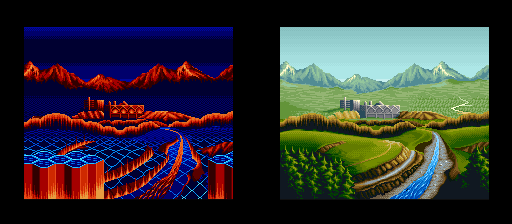
Yet, I think the coolest thing about the game is its premise and look. You aren't so much fighting aliens from outer space but creatures that slipped into our reality from a sort of cybernetic alternate dimension. By destroying various generators created by the hostile invaders you clean up what appears to be decay seeping in from a wholly digital world and returning the environment to normal: the goal of the game is to halt the spread of this digital reality virus and eliminate the various robotic bosses instigating it. It's a really distinct cyberpunk aesthetic that kind of calls to mind Supergiant Games's Transistor, in the almost meta way that its reality seems to break down into its constituent 1s and 0s. Definitely an interesting little game that goes for quality over quantity - a full playthrough takes around an hour or two.
- Preservation: Operation Logic Bomb has aged remarkably well, in part to some quality pixel artwork, a distinct look, fluid 16-bit controls, and the various tactical hooks outlined above. I would also suggest its relatively brief run-time is another point in its favor: for a full-price game, it's a little distressing to beat in an hour or so, but that's an ideal amount of longevity for a retro game that sits in a collection of others vying for your time. 4.
- Originality: The top-down on-foot shooter hasn't been a particularly big deal at any point in gaming history, even with the popularity of Smash TV, Gun.Smoke and Ikari Warriors. Most were the type that scrolled forever upwards, like standard vertical shoot 'em ups. Rarer still are games that attend to their atmosphere like Operation Logic Bomb, in which every enemy encounter must be carefully considered and the tone hops between active and suspenseful. Very few games with alternating weapons really give you a reason to keep changing to suit the occasion, rather than sticking to personal preference. 4.
- Gameplay: It's a damn smooth game and an unexpectedly user-friendly one. It actually took about an hour - halfway through the game - before I realized you could lock your shooting position, since I considered that tech to be beyond the 16-bit era. Every fight is tough but fair; you could feasibly move through most battles without a scratch with enough preparedness and reflexes (making it suitable for replays), or you could end up losing half your HP bar because an enemy got too close to easily deal with. 4.
- Style: The combination of military research base and a "digital" virus look replete with glowing blue and green hexagons is a strong aesthetic, and it becomes all the more pronounced when you move outside and start repairing patches of interdimensional rot to recover the natural landscape beneath. The robot boss designs are rad too, and that industrial synth soundtrack is wonderful (especially the almost Super Metroid-like sinister bass-y music that plays when you review footage of the invaders). 4.
Total: 16.
Other images:
The Nominee: Squaresoft's Chrono Trigger
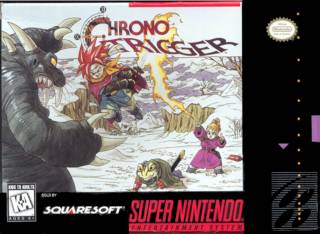
Sort of a "no, duh" entry, but we might as well get it out of the way with. Squaresoft's Chrono Trigger is perhaps the most conspicuous absence from the original SNES Classic's line-up of all time greats, not only because its production values and story quality are through the roof - and not just comparatively, but in an all-time sense - but its relative brevity (or brel...vativ...ly... nope, that wasn't a portmanteau opportunity at all, a.k.a. an opporportma- what is wrong with me today?) means it's aged better than 90% of the RPGs for the system. That isn't to say a long-ass JRPG can't make it in this day and age, but that's because games are stuffed smarter - or so we'd like to think - rather than padded out with far too many random encounters (which Chrono Trigger more or less sidesteps, both figuratively and literally) which was frequently the case back with the 16-bit era.
All that aside, my primary reason for wanting to include Chrono Trigger is - like most nominees for this project - due to its distinctiveness and longevity. It's a time-travel RPG with a generic fantasy medieval setting, a slightly less generic post-medieval setting, a prehistoric setting, a mysterious "time of the ancients" setting - mildly subverting the old "vanished advanced civilization" trope by actually letting you visit them and watching their downfall in real-time from a relatively safe distance - and a post-apocalyptic future filled with robots concerned with their inchoate stirrings of sapience. There's only one other RPG for the SNES that can match that level of thematic variance that I can think of (Live a Live, which may or may not be the focus of a future one of these) and is arguably, to this day, the greatest RPG that Squaresoft ever produced.
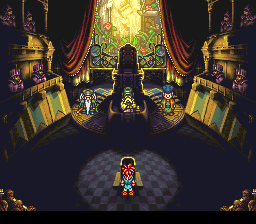
Chrono Trigger covers the exploits of a quiet kid with a katana who travels through time with a princess, a nerd, a frog, a robot, a cavewoman, and (optionally) a DBZ villain who talks about the wind a lot. I'm torn between doing my due diligence in summarizing the plot and knowing full well that anyone reading this understands precisely what Chrono Trigger involves, largely due to its Endurance Run feature on this very website, and that it was followed by a PS1 sequel, Chrono Cross, and a Satellaview broadcasted visual novel, Radical Dreamers, that followed the mysterious disappearance of one of the major side-characters. They probably also know that the game was a collaboration between Hironobu Sakaguchi (the creator of Final Fantasy), Yuji Horii (the creator of Dragon Quest) and Akira Toriyama (the creator of Dragon Ball and lead art director for Dragon Quest) in what essentially amounts to the Japanese RPG developer equivalent of the Traveling Wilburys. The only reason I can imagine for this being left off the original SNES Classic is that Squaresoft only agreed to two games, and Secret of Mana and Final Fantasy VI both won their respective coin flips (whereas Super Mario RPG got a free pass due to Nintendo's involvement).
- Preservation: Here's the odd thing about games considered truly timeless (which, when you use it to refer to Chrono Trigger in particular, seems kind of ironic): the reason they don't age is because they did everything right, which very few games can manage. That's a cop-out answer without some evidence to back it up, so here goes: the sheer amount of artistic effort put into the game's most crucial scenes, the aesthetic and gameplay variance offered by the many time travel locations, the level of freedom provided by the open end-game and the player's own decision of when and how to strike at the cosmic horror in their midst, the soulful soundtrack filled with memorable leitmotifs that perfectly suited the personalities of the characters they pertained to, the carefully considered enemy encounters that a savvy enough player can evade, and an overall run-time of 30 or so hours that lasts long enough for what feels like an epic adventure with a minimal amount of padding and grinding. It was a hard act to follow for many years after. 5.
- Originality: Chrono Trigger wasn't the first time-travel game for the SNES, but it certainly wasn't not a common theme either. More so than that, the choice to break away from the older style random encounters (where the screen would get all funky and transition to a battle) and put more emphasis on character placement and party composition with regards to the effectiveness of special attacks was relatively new. I think there was probably a conscious effort from its developers to not let the game feel like a "best of both worlds" of Final Fantasy and Dragon Quest. 4.
- Gameplay: Streamlining is the key to good game development - figure out what you need, and excise the rest. This gives you the freedom to add new ideas in the spaces left behind, or simply create a leaner and more efficient game without sacrificing anything significant. Chrono Trigger was a mixture of both of those approaches, filling its spare time with silly bike races and fairground games and optional bosses, but by ensuring that characters grew quickly - but not so quick that the constant changes to their skill repertoire wouldn't lose you in the shuffle - the game could focus less on throwing hundreds of enemies at you and more on setting the tone, introducing new puzzles and obstacles, and a tightly paced story. 4.
- Style: Toriyama's an acquired taste as far as I'm concerned, but a game like this - where he was forced to draw a frog person, a robot, and other unusual characters - really brought out his creative side. Then you have intricate vistas like Magus's Castle, the courtroom in Guardia Castle, the forest campfire scene before Lucca's dream, and the dead tree on Death's Peak, all of which someone clearly spent a lot of time crafting. But even from the ominous majesty of the Black Omen to the kitchens in ordinary homes, everything has a ridiculous level of detail. Chrono Trigger regularly pushed the SNES to absolute breaking point. 5.
Total: 18.
Other images:













Log in to comment